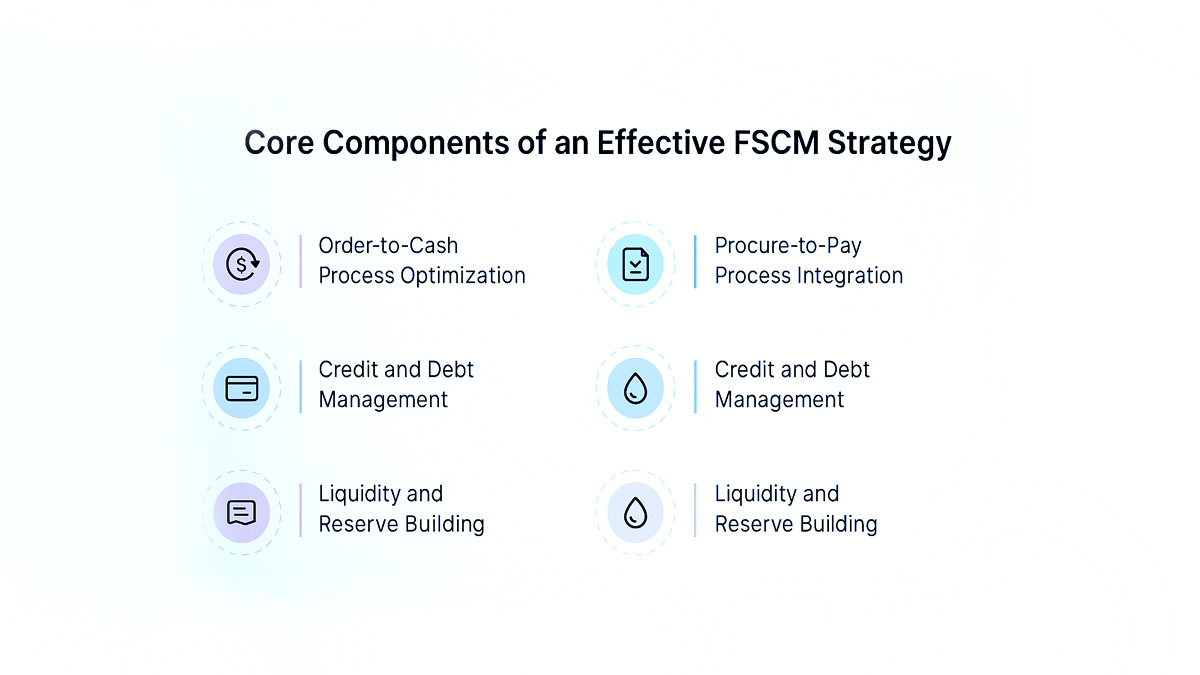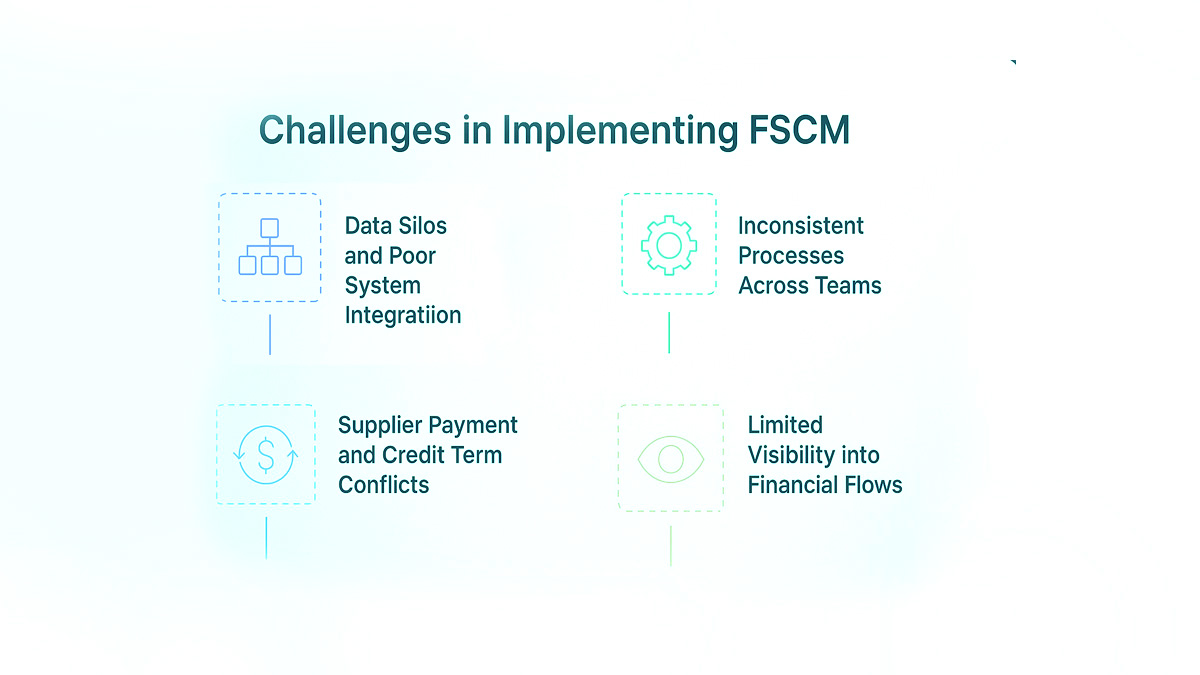

Financial Supply Chain Management: Explained

Financial Supply Chain Management: Explained
Explore financial supply chain management, its benefits, challenges, and best practices to improve cash flow, cost efficiency, and supplier relationships.


In today’s fast-paced business environment, managing financial flows efficiently is just as important as managing the movement of goods and services. Financial Supply Chain Management (FSCM) brings together finance and procurement operations to optimize working capital, reduce costs, and improve liquidity. By streamlining financial transactions across the supply chain, businesses can maintain stability,
strengthen supplier relationships, and ensure long-term growth.
What this blog covers:
- What is financial supply chain management (FSCM)
- Why FSCM matters for modern finance and procurement teams
- Core components of an effective FSCM strategy
- How FSCM aligns working capital, AP, AR, and cash flow
- Key benefits of financial supply chain optimization
- Common challenges in implementing FSCM
- Best practices for integrating finance with supply chain operations
- How Spendflo helps with financial supply chain management
- Frequently asked questions on financial supply chain management
What is Financial Supply Chain Management (FSCM)?
Financial Supply Chain Management (FSCM) optimizes financial flows between suppliers, buyers, and stakeholders to improve working capital, enhance liquidity, and reduce costs. Covering the order-to-cash and procure-to-pay cycles, it aligns payments, credit terms, and cash flow for efficient, predictable money movement.
Why FSCM Matters for Modern Finance and Procurement Teams
FSCM helps organizations maintain healthy cash flow through supply chain financing solutions, minimize financial risks, and build stronger supplier relationships through better payment terms and financial visibility. For modern finance and procurement teams, it serves as a critical tool for operational resilience and strategic decision-making.
Here are the reasons why FSCM is so important today:
Improves Working Capital Management
Effective FSCM ensures that accounts payable (AP) and accounts receivable (AR) are managed strategically, keeping cash tied up for the shortest possible time. By optimizing payment terms with suppliers and accelerating collections from customers, companies can maintain liquidity through effective cash management without resorting to unnecessary debt. This leads to better allocation of financial resources for growth and innovation.
Enhances Cash Flow Visibility and Stability
With FSCM tools and processes, finance teams gain real-time insight into incoming and outgoing payments. This transparency helps forecast cash positions accurately through robust cash flow forecasting and plan for future investments. Stable cash flow also enables companies to meet obligations on time, avoiding penalties and strengthening trust with suppliers and lenders.
Reduces Operational Costs and Inefficiencies
By streamlining the business process of financial transactions and integrating them with procurement systems, FSCM eliminates redundant manual processes and reduces the risk of payment errors. Automation in invoice matching, payment scheduling, and reconciliation further cuts operational costs, allowing teams to focus on strategic priorities instead of routine administrative tasks.
Strengthens Supplier and Stakeholder Relationships
Consistently honoring agreed-upon payment terms and maintaining financial transparency builds credibility with suppliers, manufacturers of raw materials, and other stakeholders. These strong relationships can lead to better credit terms, priority in supply allocation, and opportunities for collaborative growth. FSCM ensures that financial commitments are met without straining internal cash flow.
Mitigates Financial Risks and Disruptions
FSCM plays a key role in identifying and managing risks such as delayed payments, supplier insolvency, and currency fluctuations. By monitoring the financial health and credit ratings of supply chain partners
and ensuring diversification, businesses can minimize disruptions and protect themselves from potential losses. Proactive financial risk management keeps the supply chain resilient, even in volatile markets.
Core Components of an Effective FSCM Strategy
A successful Financial Supply Chain Management strategy combines technology, processes, and policies to ensure smooth financial flows. It addresses every stage of the transaction lifecycle, from order placement to final payment, while maintaining strong relationships with all stakeholders.

Order-to-Cash Process Optimization
The order-to-cash cycle process involves receiving customer orders, delivering goods or services, and collecting payments. Optimizing this cycle helps businesses accelerate revenue recognition and maintain steady cash inflows. Automation tools can reduce delays, improve invoicing accuracy, and track payment statuses in real time, ensuring that funds are available when needed.
Procure-to-Pay Process Integration
In the procure-to-pay cycle, businesses manage supplier selection, purchase orders, invoice approvals, and payments. Integrating procurement and finance systems ensures accurate matching of orders and invoices, prevents overpayments, avoids duplicate transactions, and supports better inventory management by aligning purchasing with stock requirements. This alignment creates a seamless flow of financial and operational data, improving efficiency and reducing manual errors.
Credit and Debt Management
Maintaining a balance between offering favorable credit terms to customers and managing debts to suppliers is essential. Effective credit management policies reduce the risk of defaults, while strategic debt management helps maintain liquidity. Monitoring customer payment behavior and supplier credit agreements allows for timely adjustments to financial terms.
Liquidity and Reserve Building
Healthy liquidity ensures that a business can cover operational expenses and invest in growth opportunities, often supported by supply chain financing, without relying on short-term borrowing. Building financial reserves provides a safety net during market downturns or supply chain disruptions. FSCM strategies often include setting aside surplus cash and optimizing interest earnings on idle funds.
How FSCM Aligns Working Capital, AP, AR, and Cash Flow
FSCM acts as the bridge that connects working capital management, accounts payable, accounts receivable, and overall cash flow. By aligning these elements, businesses can optimize the timing of cash inflows and outflows to maintain operational stability.
Accounts payable strategies focus on negotiating supplier terms that allow more time to pay without incurring penalties. Accounts receivable strategies aim to collect payments faster, using tools like electronic invoicing, automated reminders, and early payment incentives. Together, these efforts improve working capital turnover, ensuring that funds are not unnecessarily tied up in unpaid invoices or excess inventory.
This alignment also enhances forecasting accuracy, allowing finance teams to anticipate cash shortages or surpluses and make informed investment decisions. By maintaining a balanced flow between AP, AR, and working capital, businesses can improve liquidity, reduce borrowing costs, and build a more resilient financial foundation.
Key Benefits of Financial Supply Chain Optimization
Optimizing the financial supply chain delivers tangible improvements in efficiency, cost management, and risk mitigation. It ensures that financial resources are used effectively, creating a stable foundation for growth.
Improved Financial Health and Business Stability
Streamlined financial flows reduce the risk of cash shortages and improve the organization’s ability to meet obligations. Healthy liquidity levels support day-to-day operations while enabling investments in strategic initiatives. This stability boosts investor confidence and enhances long-term resilience.
Faster Payment Cycles and Reduced Delays
By removing bottlenecks in the order-to-cash and procure-to-pay processes, businesses can accelerate payment timelines. Faster payments from customers improve cash inflows, while timely payments to suppliers strengthen relationships and can secure better terms.
Better Cost Control and Resource Allocation
Optimization enables accurate tracking of expenses and ensures funds are allocated where they generate the most value. This prevents unnecessary spending, drives cost reduction in operations, and supports more informed decision-making on investments and budget planning.
Increased Efficiency Through Process Automation
Automation tools eliminate repetitive manual tasks, such as invoice matching and payment scheduling, reducing human error and freeing up time for strategic work. This efficiency leads to quicker turnaround times and more consistent financial operations.
Common Challenges in Implementing FSCM
While FSCM offers significant benefits, businesses often encounter obstacles during implementation. These challenges can hinder visibility, disrupt processes, and reduce the effectiveness of optimization efforts.

Data Silos and Poor System Integration
When finance and procurement systems operate independently, information is fragmented, making it difficult to gain a complete view of financial flows. Poor integration leads to duplicate work, missed insights, and inefficient decision-making.
Inconsistent Processes Across Teams
Without standardized procedures, different departments may handle transactions in conflicting ways. This inconsistency can cause delays, errors, and misalignment in payment cycles and cash flow management.
Supplier Payment and Credit Term Conflicts
Balancing favorable payment terms for the company with maintaining strong supplier relationships can be challenging. Disagreements over payment timelines or credit terms can strain partnerships and disrupt supply chain operations.
Limited Visibility into Financial Flows
A lack of real-time insights into incoming and outgoing payments can make it difficult to perform accurate cash flow forecasting. Limited visibility increases the risk of late payments, missed opportunities, and poor financial planning.
Best Practices for Integrating Finance with Supply Chain Operations
Integration between finance and supply chain functions ensures smooth coordination, efficient processes, and optimal use of financial resources.
Adopt Centralized Financial Platforms
Using a single, unified platform to manage procurement and financial transactions provides complete visibility and eliminates duplication. This centralization supports better tracking, faster approvals, and more informed decision-making.
Automate Financial and Procurement Workflows
Automation reduces manual errors, speeds up transaction processing, and ensures compliance with established procedures. It also enables finance teams to focus on strategic priorities rather than routine administrative work.
Establish Clear Credit and Payment Policies
Defining standardized policies for extending credit to customers and paying suppliers helps maintain consistency, manage risk, and avoid disputes. Clear policies also support stronger cash flow management.
Leverage Data Analytics for Decision Making
Analyzing financial and operational data provides valuable insights into trends, risks, and opportunities. Data-driven decision-making enables businesses to refine strategies, improve forecasting, and optimize working capital usage.
How Spendflo Helps with Financial Supply Chain Management
Spendflo streamlines financial supply chain management by providing end-to-end visibility into procurement and financial workflows. Our platform consolidates contracts, automates approvals, and integrates with accounting systems to ensure that payments, credit terms, and working capital are optimized. With real-time insights and expert negotiation support, Spendflo helps businesses reduce operational costs, improve cash flow stability, and strengthen supplier relationships, all while maximizing return on investment.
Frequently Asked Questions on Financial Supply Chain Management
What are the main benefits of FSCM?
The main benefits include improved liquidity, reduced operational costs, faster payment cycles, stronger supplier relationships, and enhanced financial visibility. Optimized financial flows also support business stability and long-term growth.
How does FSCM differ from physical supply chain management?
FSCM focuses on managing the movement of money, payments, and credit terms, while physical supply chain management deals with the flow of goods and services. Both are interconnected but address different aspects of the supply chain.
What technologies support FSCM implementation?
Key technologies include centralized financial platforms, procurement software, ERP systems and other financial services platforms, automation tools for invoicing and payment processing, and data analytics solutions for forecasting and performance monitoring.
How can FSCM improve supplier relationships?
By ensuring timely payments, clear communication, and mutually beneficial credit terms, FSCM builds trust and reliability with suppliers. This can lead to better pricing, priority service, and stronger long-term partnerships.
What metrics should be tracked in FSCM?
Important metrics include days sales outstanding (DSO), days payable outstanding (DPO), working capital turnover, invoice processing time, payment cycle efficiency, and overall cash flow position. Tracking these KPIs helps identify opportunities for improvement and risk reduction.










.png)




.png)










.avif)





